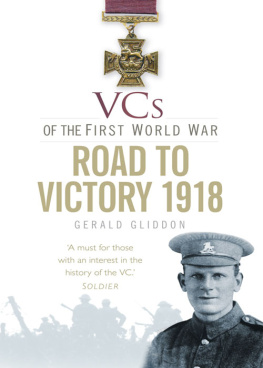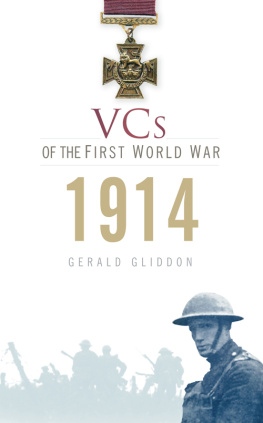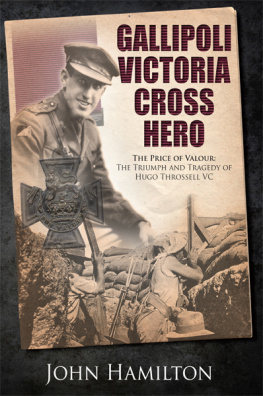Cover



Table of Contents
- Abbreviations
- Foreword
- Introduction
- 19141915
- 1916
- 1917
- 1918
- Recipients with Canadian Connections
- Aftermath
- Appendix I
- Appendix II
- Sources
- Bibliography
The Victoria Cross was introduced by Queen Victoria on January 29, 1856, to honour acts of bravery during the Crimean War. The bronze cross bears the inscription For Valour, and is cast from the metal of captured Russian guns at Sevastopol during the Crimean campaign. It is based on the design of a Maltese Cross and has a one-and-a-half-inch crimson ribbon. The decoration also contains the holders name and date.
Queen Victoria made the first awards of the VC at a public investiture held in Hyde Park on June 26, 1856, and since then 1,356 have been awarded, the most recent being to Paratrooper Lance Corporal Joshua Leakey, in February 2015.
Abbreviations
ADS Advance Dressing Station
BEF British Expeditionary Force
Bn. Battalion
BVM British Victory Medal
BWM British War Medal
CAMC Canadian Army Medical Corps
CASC Canadian Army Service Corps
CEF Canadian Expeditionary Force
CFA Canadian Field Artillery
CIB Canadian Infantry Brigade
CO Commanding Officer
Col. Colonel
Cpl. Corporal
CSM Company Sergeant Major
CWGC Commonwealth Graves Commission
DCM Distinguished Conduct Medal
DFC Distinguished Flying Cross
DSO Distinguished Service Order
GC George Cross
IG Irish Guards
L/Cpl. Lance-Corporal
Lt. Lieutenant
Lt.-Col. Lieutenant-Colonel
Maj. Major
Maj.-Gen. Major-General
MC Military Cross
MG Machine-gun
MiD Mentioned in Despatches
MM Military Medal
MO Medical Officer
OTC Officer Training Corps
Pte. Private
RAMC Royal Army Medical Corps
Regt. Regiment
RE Royal Engineers
RNWMP Royal North-West Mounted Police
SAA Small Arms Ammunition
Sgt. Sergeant
Sgt.-Maj. Sergeant-Major
VC Victoria Cross
Foreword
The Victoria Cross, the highest gallantry medal for service to the British Commonwealth, was established by Queen Victoria in 1856, during the Crimean War. The Royal Warrant for the Victoria Cross stated that it may be awarded to persons who served the Crown in the presence of the enemy, and shall have then performed some signal act of valour or devotion to their country. Soldiers and sailors of all ranks were eligible, as were civilians acting under military command. According to the Royal Warrant no previous distinctions or qualifications, such as long service, wounds, or prior meritorious conduct, were to be taken into account when an application was made. The Victoria Cross is still awarded today for high gallantry in British or Commonwealth service.
The awarding of a Victoria Cross was and indeed remains an exceedingly rare distinction: less than 1/55th of 1 percent of the approximately 420,000 men and women who served with the Canadian overseas forces was decorated with the Victoria Cross during the First World War. Recommendations for a Victoria Cross required strong support from commanding officers and, usually, corroborating evidence from at least three eyewitnesses. General eligibility requirements for the decoration evolved during the war. For instance, by late 1916 authorities determined that it would not be awarded to soldiers who had rescued wounded comrades under fire, unless the potential recipient was a designated stretcher-bearer. During the latter part of the war Victoria Crosses typically went to men whose actions were courageous as well as bellicose. Soldiers who overran enemy strongpoints against steep odds, for example, were likely candidates. Lieutenant Samuel Honeys Victoria Cross, earned at Bourlon Wood in September 1918, is a case in point.
First World War British and Dominion soldiers undoubtedly took the award very seriously, although some felt that the medal was awarded inconsistently or perhaps too rarely. Since the eligibility requirements for the Victoria Cross were so rigorous, authorities introduced lesser awards, such as the Military Cross and the Military Medal, to recognize more equitably the innumerable acts of valour exhibited in battle.
The seventy-two recipients of the Victoria Cross whose stories are told in this book each clearly displayed incredible bravery on the battlefield. Interestingly, there is no obvious pattern of common traits in their backgrounds and few clues to suggest that any of them was destined for such a great honour. Captain Francis Scrimger was a thirty-four-year-old physician when he won the VC at the Second Battle of Ypres in April 1915. By contrast, Private Tommy Holmes, a frail, delicate youth with a contagious smile, was just nineteen years old when he won his VC at Passchendaele in October 1917. Captain Billy Bishop, surely Canadas best-known VC recipient, had failed his first-year exams at the Royal Military College of Canada. It is doubtful that any of Bishops instructors would have pegged him as a future war hero.
The variety of characters whom we find among Canadas First World War Victoria Cross recipients reminds us of the broad cross section of people who served in Canadian uniform during the war, or were otherwise associated with the Canadian overseas forces. While this book has been prepared to honour their courage in particular, it bears remembering that countless others performed unseen or unrecorded heroic acts that were never formally recognized with an award or honourable mention. Although the First World War is now a century past, and its veterans no longer walk among us, let this book serve as a reminder of the very great stores of courage that helped to bring the Allied forces to final victory.
Andrew Iarocci, PhD
Assistant Professor, Department of History
Western University, London, Ontario
Introduction

Canadas VCs of the First World War
The country of Canada was part of John Cabots discovery of North America in 1497, when the French and British laid claim to its lands and potential wealth. The French were the first to establish themselves, which they did on the northeast side of the country. The British established their colony on the Atlantic coast, and in the late eighteenth century moved northward from the United States into Nova Scotia, New Brunswick, and Lower Canada. Soon Britain occupied the majority of the lands to the east and west. In 1867 the two nations joined together in a confederacy, a Union of Upper British Canada and French Lower Canada, and the country became virtually self-governing. Even so, on paper the country was still subject to the rule of the English Imperial Parliament, which installed a Governor General.
The Boer War in South Africa broke out in October 1899. Three months later the Boers attacked Ladysmith. The war, in which the British Army had received a very bloody nose, ended on May 31, 1902. Canada had taken an active part in the campaign to restore law and order in South Africa, and in doing so had won five Victoria Crosses. The Boers, a skilful enemy, had adapted very well to the terrain and revealed a number of weaknesses in the structure and, more importantly, tactics of the British Army. Over the next twelve years a considerable amount of work was carried out in order to make an efficient, yet small, standing army that would be ready for any major European conflict.




















